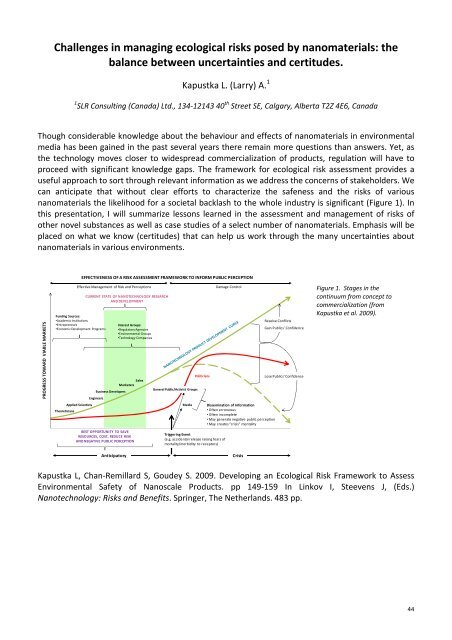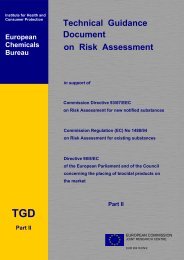Challenges of Regulation and Risk Assessment of Nanomaterials
Challenges of Regulation and Risk Assessment of Nanomaterials
Challenges of Regulation and Risk Assessment of Nanomaterials
You also want an ePaper? Increase the reach of your titles
YUMPU automatically turns print PDFs into web optimized ePapers that Google loves.
<strong>Challenges</strong> in managing ecological risks posed by nanomaterials: the<br />
balance between uncertainties <strong>and</strong> certitudes.<br />
Kapustka L. (Larry) A. 1<br />
1 SLR Consulting (Canada) Ltd., 134-12143 40 th Street SE, Calgary, Alberta T2Z 4E6, Canada<br />
Though considerable knowledge about the behaviour <strong>and</strong> effects <strong>of</strong> nanomaterials in environmental<br />
media has been gained in the past several years there remain more questions than answers. Yet, as<br />
the technology moves closer to widespread commercialization <strong>of</strong> products, regulation will have to<br />
proceed with significant knowledge gaps. The framework for ecological risk assessment provides a<br />
useful approach to sort through relevant information as we address the concerns <strong>of</strong> stakeholders. We<br />
can anticipate that without clear efforts to characterize the safeness <strong>and</strong> the risks <strong>of</strong> various<br />
nanomaterials the likelihood for a societal backlash to the whole industry is significant (Figure 1). In<br />
this presentation, I will summarize lessons learned in the assessment <strong>and</strong> management <strong>of</strong> risks <strong>of</strong><br />
other novel substances as well as case studies <strong>of</strong> a select number <strong>of</strong> nanomaterials. Emphasis will be<br />
placed on what we know (certitudes) that can help us work through the many uncertainties about<br />
nanomaterials in various environments.<br />
PROGRESS TOWARD VIABLE MARKETS<br />
EFFECTIVENESS OF A RISK ASSESSMENT FRAMEWORK TO INFORM PUBLIC PERCEPTION<br />
Effective Management <strong>of</strong> <strong>Risk</strong> <strong>and</strong> Perceptions<br />
Funding Sources:<br />
•Academic Institutions<br />
•Entrepreneurs<br />
•Economic Development Programs<br />
Theoreticians<br />
Applied Scientists<br />
CURRENT STATE OF NANOTECHNOLOGY RESEARCH<br />
AND DEVELOPMENT<br />
Business Developers<br />
Engineers<br />
Interest Groups:<br />
•Regulatory Agencies<br />
•Environmental Groups<br />
•Technology Companies<br />
Sales<br />
Marketers<br />
BEST OPPORTUNITY TO SAVE<br />
RESOURCES, COST, REDUCE RISK<br />
AND NEGATIVE PUBLIC PERCEPTION<br />
General Public/Activist Groups<br />
Politicians<br />
Triggering Event<br />
(e.g. accidental release raising fears <strong>of</strong><br />
mortality/morbidity to receptors)<br />
Damage Control<br />
Media Dissemination <strong>of</strong> Information<br />
• Often erroneous<br />
• Often incomplete<br />
• May generate negative public perception<br />
• May creates “crisis” mentality<br />
Anticipatory Crisis<br />
Resolve Conflicts<br />
Gain Publics’ Confidence<br />
Lose Publics’ Confidence<br />
Figure 1. Stages in the<br />
continuum from concept to<br />
commercialization (from<br />
Kapustka et al. 2009).<br />
Kapustka L, Chan-Remillard S, Goudey S. 2009. Developing an Ecological <strong>Risk</strong> Framework to Assess<br />
Environmental Safety <strong>of</strong> Nanoscale Products. pp 149-159 In Linkov I, Steevens J, (Eds.)<br />
Nanotechnology: <strong>Risk</strong>s <strong>and</strong> Benefits. Springer, The Netherl<strong>and</strong>s. 483 pp.<br />
44








